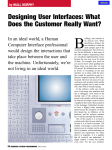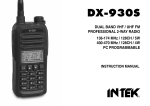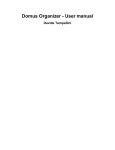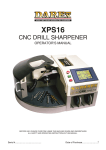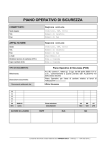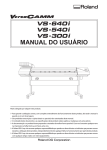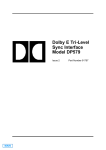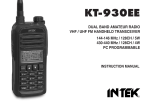Download Bedienungsanleitung Operating instructions Mode d'emploi
Transcript
*255228* 255228 TE 805 Bedienungsanleitung Operating instructions Mode d’emploi Istruzioni d’uso Gebruiksaanwijzing Manual de instruções Manual de instrucciones Brugsanvisning Käyttöohje Bruksanvisning Bruksanvisning Οδηγιες χρησεως Instrukcja obsługi Návod k obsluze Printed: 07.07.2013 | Doc-Nr: PUB / 5136333 / 000 / 00 2– 6 7–11 12–16 17–21 22–26 27–31 32–36 37–41 42–46 47–51 52–56 57–61 62–66 67–71 ORIGINAL OPERATING INSTRUCTIONS Safety instructions b) Avoid body contact with earthed or grounded surfaces, such as pipes, radiators, ranges and refrigerators. There is an increased risk of NOTE electric shock if your body is earthed or grounded. The safety rules in section 1 contain all general safec) Do not expose power tools to rain or wet conty rules for power tools which, in accordance with the ditions. Water entering a power tool will increase applicable standards, require to be listed in the operthe risk of electric shock. ating instructions. Accordingly, some of the rules listd) Do not abuse the cord. Never use the cord for ed may not be relevant to this tool. carrying, pulling or unplugging the power tool. Keep cord away from heat, oil, sharp 1. General Power Tool Safety Warnings edges or moving parts. Damaged or entangled cords increase the risk of electric shock. a) WARNING! Read all safety warnings and all instructions. Failure to follow the warn- e) When operating a power tool outdoors, use an extension cord suitable for outdoor use. ings and instructions may result in electric shock, Use of a cord suitable for outdoor use reduces fire and/or serious injury. Save all warnings and the risk of electric shock. instructions for future reference. The term “power tool” in the warnings refers to your mains- f) If operating a power tool in a damp location is unavoidable, use a residual current device operated (corded) power tool or battery-operat(RCD) protected supply. Use of an RCD ed (cordless) power tool. reduces the risk of electric shock. 1.1 Work area safety a) Keep work area clean and well lit. Cluttered or 1.3 Personal safety a) Stay alert, watch what you are doing and use dark areas invite accidents. common sense when operating a power tool. b) Do not operate power tools in explosive Do not use a power tool while you are tired or atmospheres, such as in the presence of flamunder the influence of drugs, alcohol or medmable liquids, gases or dust. Power tools creication. A moment of inattention while operating ate sparks which may ignite the dust or fumes. power tools may result in serious personal injury. c) Keep children and bystanders away while operating a power tool. Distractions can cause b) Use personal protective equipment. Always wear eye protection. Protective equipment such you to lose control. as dust mask, non-skid safety shoes, hard hat, or 1.2 Electrical safety hearing protection used for appropriate conditions will reduce personal injuries. a) Power tool plugs must match the outlet. Never modify the plug in any way. Do not use any c) Prevent unintentional starting. Ensure the switch is in the off-position before connectadapter plugs with earthed (grounded) powing to power source and/or battery pack, picker tools. Unmodified plugs and matching outlets ing up or carrying the tool. Carrying power tools will reduce risk of electric shock. d) e) f) g) with your finger on the switch or energising power tools that have the switch on invites accidents. Remove any adjusting key or wrench before turning the power tool on. A wrench or a key left attached to a rotating part of the power tool may result in personal injury. Do not overreach. Keep proper footing and balance at all times. This enables better control of the power tool in unexpected situations. Dress properly. Do not wear loose clothing or jewellery. Keep your hair, clothing and gloves away from moving parts. Loose clothes, jewellery or long hair can be caught in moving parts. If devices are provided for the connection of dust extraction and collection facilities, ensure these are connected and properly used. Use of dust collection can reduce dustrelated hazards. 1.4 Power tool use and care a) Do not force the power tool. Use the correct power tool for your application. The correct power tool will do the job better and safer at the rate for which it was designed. b) Do not use the power tool if the switch does not turn it on and off. Any power tool that cannot be controlled with the switch is dangerous and must be repaired. c) Disconnect the plug from the power source and/or the battery pack from the power tool before making any adjustments, changing accessories, or storing power tools. Such preventive safety measures reduce the risk of starting the power tool accidentally. d) Store idle power tools out of the reach of children and do not allow persons unfamiliar with the power tool or these instructions to oper- ate the power tool. Power tools are dangerous in the hands of untrained users. e) Maintain power tools. Check for misalignment or binding of moving parts, breakage of parts and any other condition that may affect the power tool’s operation. If damaged, have the power tool repaired before use. Many accidents are caused by poorly maintained power tools. f) Keep cutting tools sharp and clean. Properly maintained cutting tools with sharp cutting edges are less likely to bind and are easier to control. g) Use the power tool, accessories and tool bits etc. in accordance with these instructions, taking into account the working conditions and the work to be performed. Use of the power tool for operations different from those intended could result in a hazardous situation. 1.5 Service a) Have your power tool serviced by a qualified repair person using only identical replacement parts. This will ensure that the safety of the power tool is maintained. 2. Additional safety precautions 2.1 Personal safety a) Wear ear protectors. Exposure to noise can cause hearing loss. b) Use auxiliary handle(s), if supplied with the tool. Loss of control can cause personal injury. 7 Printed: 07.07.2013 | Doc-Nr: PUB / 5136333 / 000 / 00 c) Hold power tool by insulated gripping surfaces, when performing an operation where the cutting accessory may contact hidden wiring or its own cord. Cutting accessory contacting a "live" wire may make exposed metal parts of the power tool "live" and could give the operator an electric shock. d) Always hold the tool securely, with both hands on the grips provided. Keep the tool, especially its grip surfaces, clean and free from oil and grease. e) Breathing protection must be worn when the tool is used without a dust removal system. f) Exercise your fingers during pauses between work to improve the blood circulation in your fingers. g) To avoid tripping and falling when working, always lead the sypply cord, extension cord and dust extraction hose away tho the rear. h) The tool is not intended for use by children, by debilitated persons or those who have received no instruction or training. i) Children must be instructed not to play with the tool. j) Dust from material such as paint containing lead, some wood species, minerals and metal may be harmful. Contact with or inhalation of the dust may cause allergic reactions and/or respiratory diseases to the operator or bystanders. Certain kinds of dust are classified as carcinogenic such as oak and beech dust especially in conjunction with additives for wood conditioning (chromate, wood preservative). Material containing 8 Printed: 07.07.2013 | Doc-Nr: PUB / 5136333 / 000 / 00 to the surface of the tool may, under unfaasbestos must only be treated by spevorable conditions, present a risk of eleccialists. Where the use of a dust extractric shock. tion device is possible it shall be used. To achieve a high level of dust collection, use a suitable vacuum cleaner of 2.3 Power tool use and care the type recommended by Hilti for wood a) Ensure that the insert tools used are equipped with the appropriate connecdust and/or mineral dust together with tion end system and that they are propthis tool. Ensure that the workplace is erly fitted and secured in the chuck. well ventilated. The use of a dust mask of filter class P2 is recommended. Fol- b) In the event of a power faillure, switch the tool off and unplug the supply cord. low national requirements for the mateThis prevents inadvertent starting when rials you want to work with. the power returns. 2.2 Electrical safety 2.4 Work area a) Before beginning work, check the work- a) Ensure that the workplace is well lit. ing area (e.g. with a metal detector) to b) Ensure that the workplace is well venensure that no concealed electric tilated. Poorly ventilated workplaces cables or gas and water pipes are premay be injurious to the health due to sent. External metal parts of the tool may exposeure to dust. become live if, for example, an electric cable is damaged inadvertenly. This pre- 2.5 Personal protective equipment The user and any other persons in the sents a serious risk of electric shock. b) Check the condition of the supply cord vicinity must wear suitable eye protection, and its plug connections and have it a hard hat, ear protection and protective replaced by a qualified electrician if gloves when the tool is in use. Breathing damage is found. Check the condition protection must be worn if no dust removal of the extension cord and replace it if system is used. damage is found. Do not touch the supply in the event of it suffering damage while working. Disconnect the supply cord plug from the socket. Damaged Wear ear Wear eye Wear a supply cords and extension cords pre- protection protection hard hat sent a risk of electric shock. c) Dirty or dusty electric tools should thus be checked at a Hilti service center at regular intervals, especially if used frequently for working on conductive mateWear Wear rials. Dust (especially dust from con- protective breathing ductive materials) or dampness adhering gloves protection The general safety precautions for power tools contain all product-specific precautions for the power tool described in these operating instructions. The precautions listed under (1.3 c, d, f, g) are not relevant to this power tool. 1 Hilti TE 805 breaker Technical data 2 Items supplied as standard – Power tool – Side handle – Grease – Cleaning cloth – Operating instructions – Hilti toolbox 3 Symbols Read the operating instructions before use. 4 Power input: 1350 W 1350 W 1350 W 1350 W 1350 W 1350 W Voltage (versions): 100 V 110 V 120 V 220 V 230 V 240 V Current input: 13.5 A 13 A 11 A 6.5 A 6.5 A 6.0 A Frequency: 50–60 Hz Weight as per EPTA-Procedure 01/2003:10.3 kg Dimensions: 600×120×230 mm Hammering speed under load: 2000 blows/min. Single impact energy: 17 joules Chiselling performance in medium- hard concrete: 1200 cm3/min. Chisels: Ponted, flat, wide flat, asphalt and flexible chisels Bushing, tamping and ground-rod ramming tools Chuck: TE-S Permanent lubrication Adjustable side handle Foam-rubber padded grip and side handle Automatic cut-out carbon brushes Electronic speed (r.p.m.) limitation On / off switch Protection class ll (double insulated) Radio and TV interference suppression as per EN 55014-1 Return waste material for recycling. Do not use this product in any way other than as directed by these operating instructions. Observe the national regulations applicable to the operation of this machine. The operating instructions should always be kept with the machine! -NOTEThe vibration emission level given in this information sheet has been measured in accordance with a standardised test given in EN 60745 and may be used to compare one tool with another. It may be used for a preliminary assessment of exposure. The declared vibration emission level represents the main applications of the tool. However if the tool is used for different applications, with different accessories or poorly maintained, the vibration emission may differ. This may significantly increase the exposure level over the total working period. An estimation of the level of exposure to vibration should also take into account the times when the tool is switched off or when it is running but not actually doing the job. This may significantly reduce the exposure level over the total working period. Identify additional safety measures to protect the operator from the effects of vibration such as: maintain the tool and the accessories, keep the hands warm, organisation of work patterns. 9 Printed: 07.07.2013 | Doc-Nr: PUB / 5136333 / 000 / 00 Sound and vibration information (according to EN60745): A-weighted sound power level: 101 dB (A) A-weighted emission sound pressure level: 90 dB (A) For the given sound power level as per EN 60745, the tolerance is 3 dB. Ear protection must be worn Triaxial vibration value (vibration vector sum) measured in accordance with EN 60745-2-6 Chiselling, (ah, Cheq): 15.0 m/s2 Uncertainty (K) for triaxial vibration value: 1.5 m/s2 Right of technical modifications reserved! Operating the TE805 breaker Before starting work Read the safety precautions. The machine should be used only for the applications for which it is intended, i.e. chiselling, bushing, packing, cutting and driving in mineral materials such as concrete, masonry and asphalt etc. It is not suitable for use on metal surfaces. The breaker must be in good working order and used as directed (side handle firmly tightened in the correct position and chisel secured properly in the chuck). The electric mains supply must correspond to the information printed on the rating plate. The machine is double insulated. Earthing/ grounded of this machine is not permitted. Fig. 1: Cleaning chisel connection ends The chuck is not incorporated in the machine’s lubrication system. The con10 Printed: 07.07.2013 | Doc-Nr: PUB / 5136333 / 000 / 00 nection ends of chisels and other tools must therefore be cleaned regularly and lubricated with Hilti grease. Use a dust shield on the chisel. chuck in the desired position, against spring pressure, until it locks automatically. To remove the chisel, pull back the locking sleeve and pull out the chisel. surfaces, clean and free from oil and grease. Do not use cleaning agents which contain silicone. The outer casing of the tool is made from impactresistant plastic. Sections of the grip are made from a synthetic rubber materiFig. 3: Side handle Move the side handle to the desired posi- al. Never operate the tool when the ventition and clamp it securely by tightening the lation slots are blocked. Clean the ventilation slots carefully using a dry brush. Do knob. not permit foreign objects to enter the interior of the tool. Clean the outside of the tool Fig. 4: Beginning work Switch on the breaker and bring the blade at regular intervals with a slightly damp of the chisel into contact with the work sur- cloth. Do not use a spray, steam pressure face. It is not necessary to apply constant cleaning equipment or running water for finger pressure to the switch as it remains cleaning. This may negatively affect the in the ON position for sustained operation. electrical safety of the tool. Servicing Starting time at low temperatures The starting time (until the hammering The TE 805 is equipped with automatic cutaction begins to operate) can be reduced out carbon brushes which break the powby jolting the chisel against the working er circuit after a predetermined period of surface as the machine is switched on. operation, indicating that the machine requires to be serviced. Failure to observe Operation this point could result in expensive conseWhile working, hold the machine securequential damage to the machine. ly with both hands, using the grip and side Electric tools must comply with the applichandle. Check the security of the stance or able safety regulations. Servicing, thereposition from which you are working at fore, may be carried out only by recognised regular intervals (ladders do not provide a electrical specialists. The use of original secure stance and present an accident hazHilti parts ensures optimum safety. ard). Do not apply excessive pressure - this will not increase the machine’s performance. Simply position and guide the chisel. Care of the electric tool Fig. 2: Inserting a chisel Insert the chisel by pushing it into the -CAUTIONKeep the power tool, especially its grip Insert tool reconditioning Insert tool reconditioning should be carried out only by authorised specialists. If the blade of a pointed, flat or wide-flat chisel is only slightly worn, it can be resharpened by grinding. Note: Ensure that the surface of the chisel does not overheat when grinding (no discoloration). If the blade of a pointed or flat chisel is badly worn, it requires to be reforged. Heat the tip of the chisel (approx. 80 mm) to approx. 1000–1100° C (bright yellowred to yellow) and forge to shape. Allow the chisel to cool slowly to room temperature (avoid draughts!). Do not reharden and temper the chisle. Chisel grinding angles EC declaration of conformity (original) Manufacturer's warranty – tools Breaker Hilti warrants that the tool supplied is free of defects in material TE805 and workmanship. This warranty is valid so long as the tool is operated and handled correctly, cleaned and serviced properly 1996 and in accordance with the Hilti Operating Instructions, and the We declare, under our sole responsibility, that this product com- technical system is maintained. This means that only original Hilti Flat chisel consumables, components and spare parts may be used in the plies with the following directives and standards: 2006/42/EC, 2004/108/EC, 2000/14/EC, EN 60745-1, EN 60745-2- tool. 6, EN ISO 12100, 2011/65/EU. This warranty provides the free-of-charge repair or replacement Wide flat of defective parts only over the entire lifespan of the tool. Parts chisel Measured sound power level LWA: 100 dB/1pW requiring repair or replacement as a result of normal wear and Guaranteed sound power level LWAd: 102 dB/1pW tear are not covered by this warranty. Conformity assessment procedure: 2000/14/EC Additional claims are excluded, unless stringent national rules Disposal Annex VI prohibit such exclusion. In particular, Hilti is not obligated for Most of the materials from which European Notified Body: TÜV NORD CERT, direct, indirect, incidental or consequential damages, losses Hilti power tools are manufactured Am TÜV 1, 30519 Hannover, or expenses in connection with, or by reason of, the use of, or can be recycled. The materials Germany inability to use the tool for any purpose. Implied warranties of must be correctly separated before they can merchantability or fitness for a particular purpose are specifbe recycled. In many countries, Hilti has ically excluded. already made arrangements for taking back Hilti Corporation, Feldkircherstrasse 100, your old electric tools for recycling. Please FL-9494 Schaan For repair or replacement, send tool or related parts immediateask your Hilti customer service department ly upon discovery of the defect to the address of the local Hilti or Hilti sales representative for further informarketing organization provided. mation. This constitutes Hilti's entire obligation with regard to warranty Only for EU countries Paolo Luccini Jan Doongaji and supersedes all prior or contemporaneous comments and oral Disposal of electric tools together Head of BA Quality and Process Management Ececutive Vice President or written agreements concerning warranties. BA Electric Tools & Accessories BU Power Tools & Demolition with household waste is not per- 01/2012 01/2012 missible! In observance of European Directive on waste electrical and electronic equipment Technical documentation filed at: and its implementation in accordance with Hilti Entwicklungsgesellschaft mbH national law, electric tools that have Zulassung Elektrowerkzeuge reached the end of their life must be col- Hiltistrasse 6 lected separately and returned to an envi- 86916 Kaufering ronmentally compatible recycling facility. Deutschland Pointed chisel Description: Designation: Year of design: 11 Printed: 07.07.2013 | Doc-Nr: PUB / 5136333 / 000 / 00 Hilti Corporation Hilti = registered trademark of Hilti Corp., Schaan W 2014 0113 10-Pos. 1 1 Printed in Liechtenstein © 2013 Right of technical and programme changes reserved S. E. & O. Printed: 07.07.2013 | Doc-Nr: PUB / 5136333 / 000 / 00 255228 / A2 LI-9494 Schaan Tel.: +423 / 234 21 11 Fax: +423 / 234 29 65 www.hilti.com







